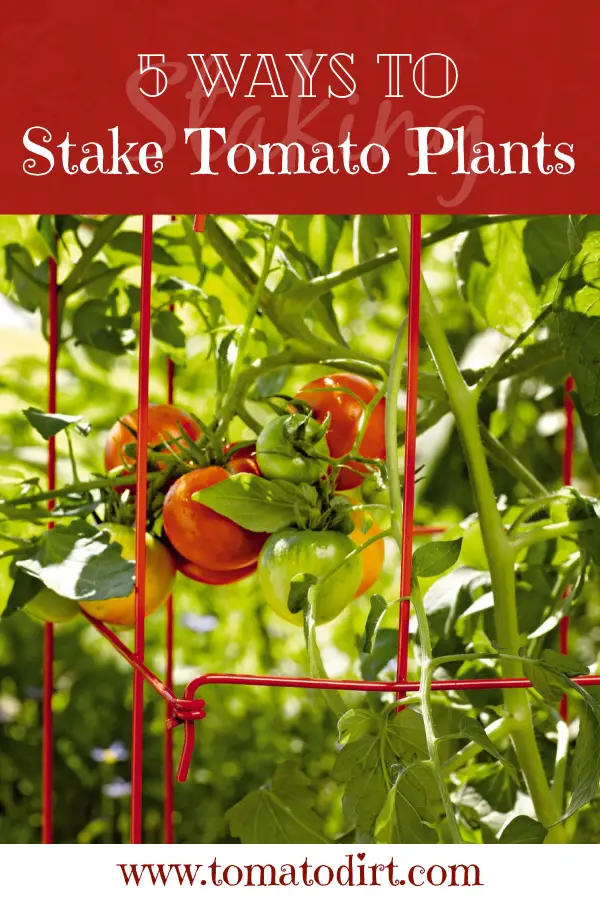FREE: 10 Must-Know Tomato Growing Tips Get The Guide
Read our affiliate disclosure here.
5 Ways to Stake Tomatoes Easily and Successfully
Since 2010, Tomato Dirt has garnered 4.8+ million views, making it the web’s leading online source for growing tomatoes in the home garden. Award-winning writer and Tomato Dirt owner Kathy Widenhouse has helped thousands of home gardeners grow healthier tomatoes. Be one of them when you get Tomato Dirt’s Growing Guide here.
Updated 5.13.24
Do you need to stake tomatoes in order to get a healthy crop of fruit? No.
But it’s a good idea.
When you stake tomatoes, you give plants extra support. Stems to grow stronger. Also, as tomato plants grow vertically, you have more room in your garden for other crops … or more tomatoes.
Plus, staking tomatoes keeps leaves and fruit off the ground and helps prevent the spread of diseases.
There are at least 5 tomato staking methods you can use successfully. Gardeners have found all five work well. Each has advantages. Learn more about different tomato staking methods and experiment. If you have success with one, use it again next season.
5 Ways to Stake Tomatoes
1. Stake tomatoes with cages
Tomato cages encircle a plant with support.
- Plant your tomatoes before staking.
- Build your own tomato cages or purchase tomato cages. Tomato towers also double as tomato cages.
- Push the legs of the tomato cage into the ground with the plant in the center.
- Use a rubber headed hammer to drive the tomato cage into the ground for more stability.
- As the tomato plant grows, tie new branches to the sides of the cage throughout the season.
- If your plant grows taller than the cage height, add a cage extension.
2. Stake tomatoes with individual posts
Individual tomato stakes are a good option if you’re growing only a few plants.
- Plant your tomatoes before staking.
- Choose any kind of sturdy post: wooden stakes, stakes made from bamboo, T-posts (steel fence posts used to support wire fencing), or even thin-diameter PVC pipe. You can also purchase tomato spirals to serve as individual stakes. You need one post per plant.
- Drive stakes into the ground at the base of each tomato plant.
- Tie the plant’s main stem to the stake.
- Continue to tie stems to the stake as the plant grows throughout the season.
3. Stake tomatoes with a trellis
A tomato trellis is one of the cheapest ways to stake tomatoes.
- Before planting tomatoes, create the trellis frame. Drive T-posts into ground about every 4-6 feet apart. Attach a horizontal bar across the top of the vertical posts.
- Plant tomato plants in the ground beneath the trellis frame.
- Twist or loop one end of a piece of twine to a tomato stem. Run the twine up to the trellis crossbeam, loop it over, run it back to the plant, and secure it again on the stem.
- The tomato plant will grow up the twine for support.
- A tomato trellis works best when you are growing a row of tomato plants rather than only one or two.
4. Stake tomatoes with a Florida weave
A Florida weave is a tomato trellis variation.
- Before planting tomatoes, drive T-posts into ground about every 4-6 feet apart.
- Set plants in ground about every 2 feet apart.
- Tie twine to one T-post a few inches lower than the average height of the plants. Thread the twine in between plants, weaving it first one one side of one plant and then on the other side of the next.
- Weave additional layers of twine around plants as the plant grows throughout the season.
- A Florida weave works best when you are growing a row of tomato plants rather than only a few.
5. Stake tomatoes with fencing panels
A fencing panel provides extra support for tomato plants.
- Set up panels before planting tomatoes.
- Drive stakes or T-posts into the ground about 4-6 feet apart.
- Place welded wire grids or a fencing panel flat against stakes. Use zip ties or wire to attach wire panels to the T-posts.
- Plant tomatoes at the base of the panels.
- Weave tomato stems in and out of panel grids as they grow throughout the season.
- Tie stems to panel grids for additional support.
- Agricultural panels work best when you are growing a row of tomato plants rather than only a few.
What are the best stakes for tomatoes?
That depends!
If you have just a few tomato plants, then tomato cages or individual tomato stakes are a good choice. Set up is quick. And you can tie new branches to the cage or stake every week or two throughout the season.
But if you have a row of tomatoes, you may want to consider staking tomatoes with a tomato trellis, a Florida weave, or a fence panel. Initial set up will take longer. But then, for the rest of the season, you simply need to train new branches onto the trellis cords or lace a new twine around new branches into your Florida weave or tie a few supports to the panel.
More about staking tomatoes
How to stake and tie tomatoes for support ...
3 Do-It-Yourself Tomato Trellis Ideas ...
How to build tomato cages for support ...
How to tie up tomato plants ...
How to build a tomato trellis for staking tomatoes ...
Staking tomatoes: advantages and disadvantages ...
Review: Tomato Cages from Gardener's Supply ...
The perfect tomato staking tape ...
More staking tips on our Pinterest board ...
Return from 5 Ways to Stake Tomatoes to Tomato Dirt home
As an Amazon Associate and Rakuten Advertising affiliate I earn from qualifying purchases.
SHARE THIS PAGE:
FREE! 10 Must-Know Tomato Growing Tips: 20-page guide
Get yours here:




